UPDATE (09.17.2022): I am changing the plan for v1.0.0 v0.8.0 of the enhanced NYC subway due to recent ridership trends – see the edit toward the end of this post.
Welcome to my NYTIP series! As part of NYTIP, I outlined a three-point plan for fixing the NYC Subway:
- Enhance (minimize merging conflicts)
- Extend (extend existing lines)
- Expand (build new lines)
I’ll begin my series on point 1 – enhance – with the Central Park West (CPW) trunk line, which serves the A, B, C, and D trains.
Note: Click any image to enlarge.
[Fig. 1] Snippet of the NYC Subway map featuring the CPW trunk line.
The CPW trunk line, as its name implies, runs along the west side of Central Park for most of its length. It serves the west side of Manhattan from 145th Street to 59th Street – Columbus Circle. Two 8th Avenue services from Inwood and Washington Heights (A express and C local) and two 6th Avenue services from The Bronx (B local and D express) serve the trunk. Under the current setup, the A and D run express, and the B and C run local. This setup induces merging conflicts for both local and express services at two points – south of 145th Street and south of 59th Street. Making matters worse, the A, B, C, and D each have differing frequencies, increasing the likelihood of delays.
[Figs. 2, 3] Existing merging conflicts on the CPW trunk line. The original track map belongs to vanshnookenraggen (PDF).
Now, removing these conflicts isn’t a novel idea. For example, Alon Levy’s de-interlining plan suggests an A/C express and B/D local, while a similar plan reverses this paradigm – A/C local, B/D express. The Regional Plan Association, in their Save our Subways publication, goes even further – RPA’s plan truncates the C to a Brooklyn shuttle to double A express service, while the B and D run via CPW local. There are pros and cons to each of these proposals, though NYTIP does not prescribe anything as drastic as RPA’s plan for CPW.
When I first published this post in early 2019, I recommended swapping the C and D lines as the cheapest way to de-interline (or, to use less wonky language, redesign) CPW. However, I gave more thought to other options. I recall the M-V combo controversy from last decade – MTA originally called this route the V, but riders preferred the historic M designation, and so the latter stuck. If a C/D swap generates a similar controversy, then another alternative would be better.
Thankfully, it’s possible to redesign CPW in a way that allows both Upper Manhattan and The Bronx to retain full-time express service while minimizing potential rider confusion. I will explore two options that achieve this, along with a third option that enhances the existing service pattern.
Option 1: 8th Avenue service express, 6th Avenue service local
[Figs. 4, 5] Overview of Option 1. Created using Brand New Subway, with modifications by me.
[Figs. 6, 7] Merging conflicts removed through Option 1.
Option 1 implements a modified version of the original operating pattern. Under Option 1, service is as follows:
- A: CPW/8th Avenue express from Inwood – 207th Street
- B: CPW local/6th Avenue express from Washington Heights – 168th Street
- C: CPW/8th Avenue express from Norwood – 205th Street
- D: CPW local/6th Avenue express from Bedford Park Boulevard
Let’s look at some implications.
C/D Service in The Bronx
Under Option 1, both C and D trains serve The Bronx all day, every day, to encourage ridership. The C runs with a mix of 480-foot and 600-foot trains due to available rolling stock, but it would run much more frequently than at present. The D would replace the C during overnight hours. There are still some merging conflicts between C and D trains since the Concourse line only has three tracks. However, when the C runs express in The Bronx, it does not merge with the D.
In previous versions of this post, I floated the idea of converting 161st Street – Yankee Stadium station to an express stop since it’s the busiest station in The Bronx:
[Fig. 8] Overview of the optional 161st Street – Yankee Stadium lower level conversion.
While such a conversion would make the C express service more attractive, especially given that 161st Street is a major transfer point between lines serving opposite sides of Manhattan, it would be an expensive, disruptive undertaking. Therefore, v0.8.0 of the enhanced NYC subway would not include this conversion.
A 4-Track Concourse Line?
Original plans for the Concourse line called for 4 tracks, but funding shortfalls resulted in only three tracks. While 4 tracks are nice to have to fully eliminate merging conflicts and encourage ridership, NYTIP does not contemplate this conversion – yet. (Honestly, I love the idea.)
A/C Service in Brooklyn
Option 1 does not affect A/C service in Brooklyn – the A remains express and the C remains local.
8th Avenue Local Service
Under Option 1, the E is the sole 8th Avenue local service. Consequently, one must transfer at 7th Avenue – 53rd Street to the B/D to travel between the 8th Avenue local stops (50th Street, 23rd Street, and Spring Street) and points north of 59th Street. However, this is a cross-platform transfer regardless of direction. 50th Street is an interesting case since the E serves the lower level platforms. What happens to the upper level platforms?
Alternative 1: 50th Street served by E trains only
While this is the simplest option, it results in a de facto closure of the upper level platforms, or conversion to a split mezzanine. Over 6.9 million passengers used this station in 2019, making it the 2nd-busiest local stop on the 8th Avenue/CPW corridor. One possible mitigation strategy for the loss of the C local is increasing 8th Avenue local service from Queens as part of a Queens Boulevard subway redesign.
Alternative 2: Convert 50th Street to an express stop
There is no easy way to do this since there are no provisions for switches north of the station. Therefore, any such conversion would involve column demolition and replacement – either for new switches or platform extensions. Due to the disruptions this would cause, Alternative 1 is a better fit for Option 1.
Option 2: 8th Avenue service local, 6th Avenue service express
[Figs. 9, 10] Overview of Option 2.
[Figs. 11, 12] Merging conflicts removed through Option 2.
Under Option 2, service is as follows:
- A: CPW/8th Avenue local from Washington Heights – 168th Street
- B: CPW/6th Avenue express from Inwood – 207th Street
- C: CPW/8th Avenue local from Bedford Park Boulevard
- D: CPW/6th Avenue express from Norwood – 205th Street
Let’s look at some implications.
C/D Service in The Bronx
Option 2 prescribes the same improvement to C trains as Option 1 – namely, more frequent service. The C replaces the B as the Concourse local, while there is no change to D service other than service increases. As with Option 1, C and D trains serve The Bronx all day under Option 2.
8th Avenue Service
Under Option 2, the A and C run local and the E runs express. This prevents congestion and merging delays, while preserving service levels at both local and express stations. The C terminates at World Trade Center station, while the E would continue to Brooklyn with the A. Owing to the existing track layout, select E trains can turn at 34th Street – Penn Station or Canal Street in Manhattan to preserve regularity in Queens.
A/E Service in Brooklyn
Under Option 2, the A runs express and the E runs local. Since the E is generally more frequent than the C, additional rolling stock would be required to facilitate the E train extension without cutting service elsewhere.
EDIT (09.17.2022): Recent ridership trends – particularly in The Bronx – have given me pause concerning my service plan for CPW. Specifically, COVID ridership recovery on the Concourse line has been very weak compared to the rest of The Bronx.
Twitter user UrbaneUrban created a map showing COVID ridership recovery as of August 2022. Green represents at least 49% ridership recovery, while the gradients approaching red indicate lower ridership recovery. As the map shows, ridership recovery is much lower on Concourse (31% as of August 2022) than on the other Bronx subways. Infrequent service, frequent delays, and recent construction work all contribute to this shortfall. (As a sanity check, I checked the recovery numbers as of 09.16.2022. Ridership recovery on the Concourse line has improved, but it is still lagging behind the other Bronx subways.) Since ridership recovery on the nearby 4 line is much higher than that of the Concourse line and 4 service is generally more frequent than D service, this suggests that Bronx ridership recovery is highly sensitive to service frequency.
Therefore, I will now consider a third option that mitigates conflicts and increases service substantially while preserving the current pattern.
Option 3: Interlined service enhancement
[Figs. 13, 14, 15] Overview of Option 3.
There are two main elements to Option 3. The first is a B/C swap north of 145th Street. The purpose of this swap is to mitigate conflicts between B and D trains at 59th Street – Columbus Circle southbound and 145th Street northbound. The key to these mitigations is scheduling. Since the B, C, and D trains would operate at the same frequency at all times (every 6 minutes each), the B and D would be scheduled to meet somewhere in Harlem in both directions. This ensures even spacing on the B and D lines. (This would be more challenging during peak hours since the A would be more frequent than the D.)
The second element is a C/E swap south of 50th Street station. The C would run local to the World Trade Center (WTC), while the E would run express in Manhattan and local in Brooklyn. Due to rolling stock availability, some peak-hour E trains would turn at WTC; however, the Fulton Street local stations would see E service every 6 minutes all day – a significant service increase.
Summary
As you can see, the de-interlining options significantly reduce merging conflicts through the CPW corridor while preserving direct local and express service from both Upper Manhattan and The Bronx. Both de-interlining options have their pros and cons. A particular advantage of Option 2 over Option 1 is preserved service levels at all stations. However, Option 2 does not remove as many merging conflicts as Option 1 does.
I’ve gone back-and-forth on these options in the various beta versions of the enhanced NYC subway. For v1.0.0, after careful consideration, I have chosen Option 1. I have decided to scrap the CPW de-interlining in favor of all-day service increases. These service increases should accelerate COVID ridership recovery, especially on the Concourse line in The Bronx; both C and D trains would serve The Bronx all day, including on weekends. Thus, v0.8.0 of the enhanced NYC subway would now incorporate Option 3.
The Bottom Line
The CPW redesign would affect A, B, C, D, and E service. The table below shows current frequencies and proposed frequencies under NYTIP (in minutes) for each of these lines. Of the E’s 15 peak trains per hour (TPH), 10 TPH would run to Brooklyn and 5 TPH (all Jamaica – 179th Street departures plus two Jamaica Center departures per hour) would turn at WTC.
| Service | Current Service (Weekday Peak/Weekday Off-Peak/Weekend) | Proposed NYTIP Service (Peak/Off-Peak) |
| A | 4.3 / 7-10 / 10 | 4 / 6 |
| B | 6 / 10 / – | 6 / 6 |
| C | 8.6 / 10 / 12 | 6 / 6 |
| D | 6 / 10 / 12 | 6 / 6 |
| E | 4 / 8 / 12 | 4 / 6 |

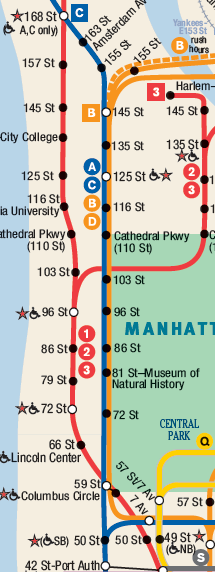
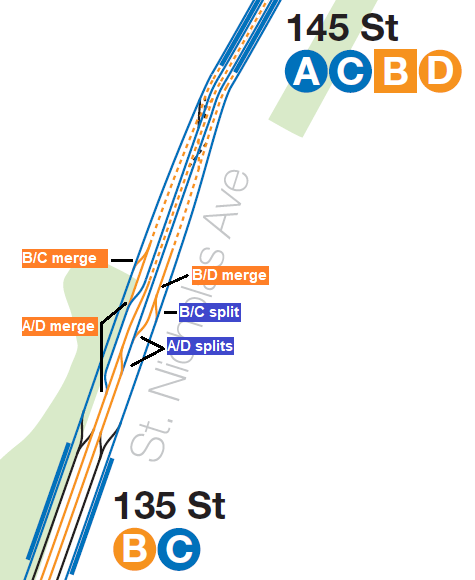
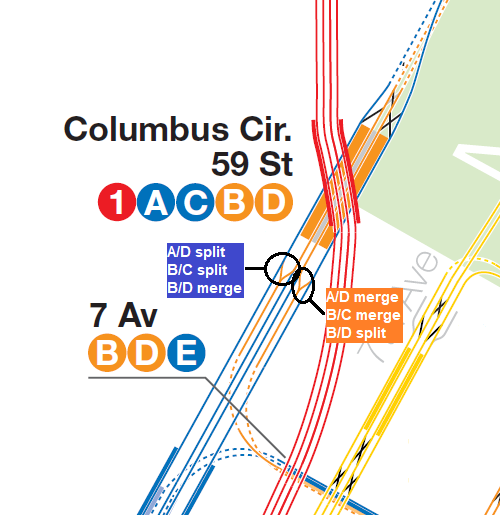
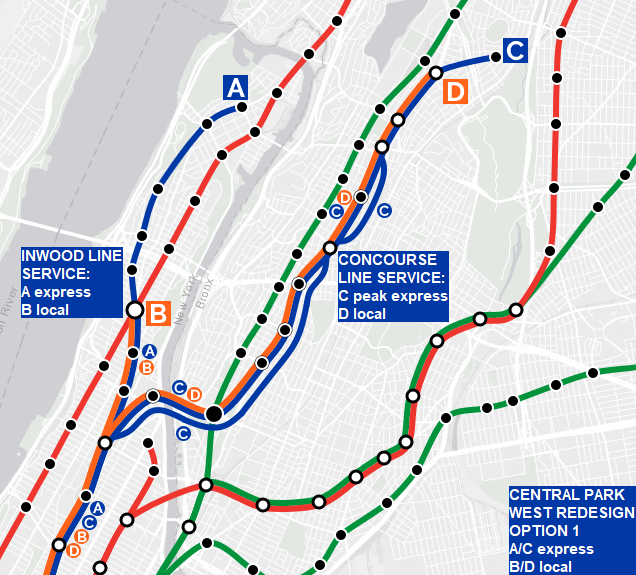
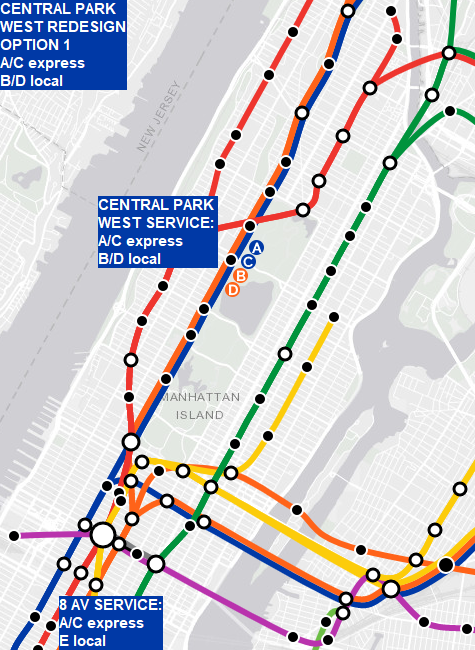
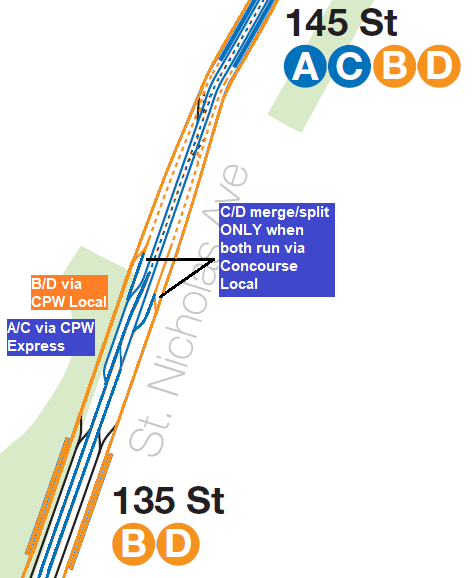
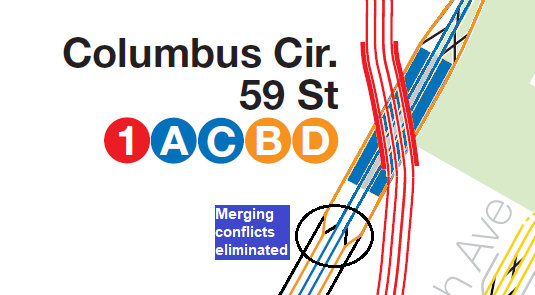
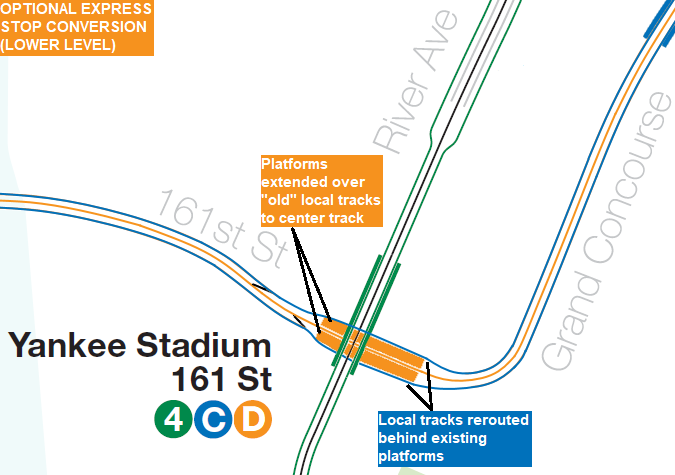
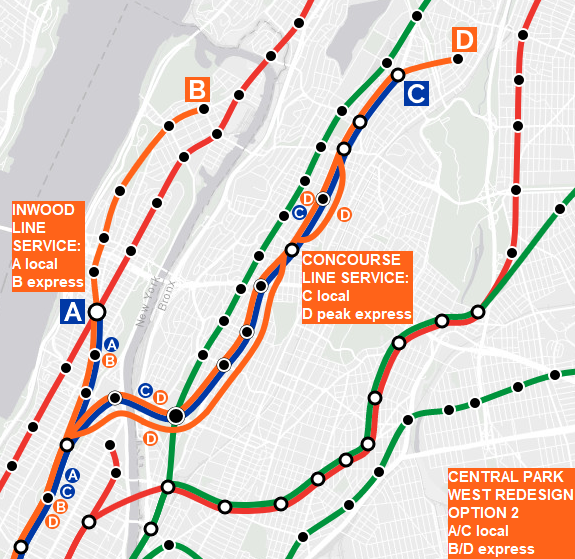
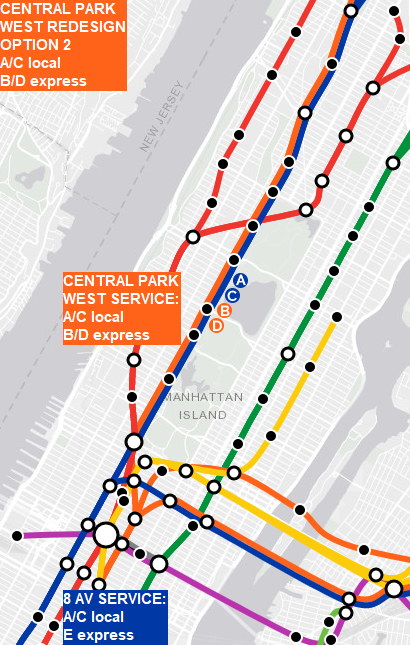
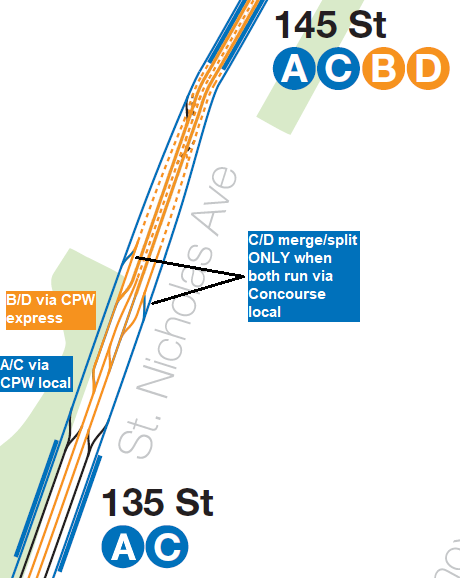
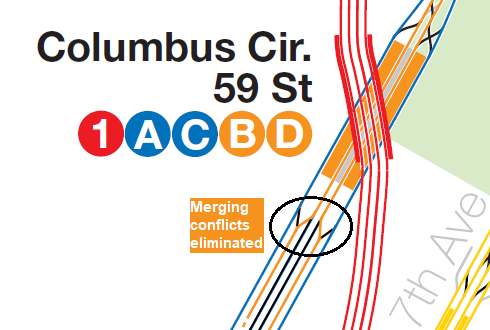
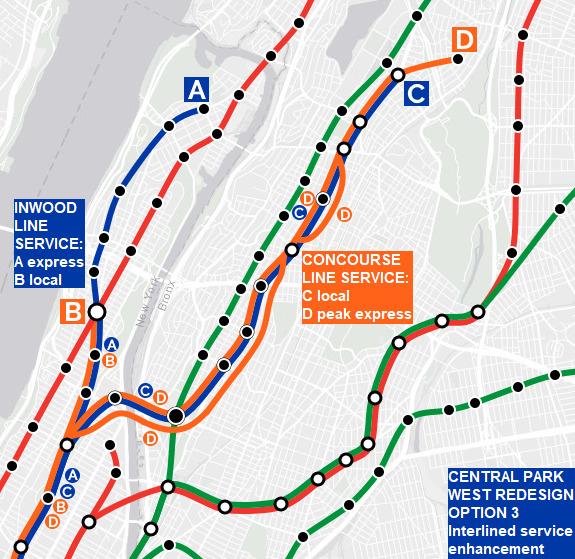
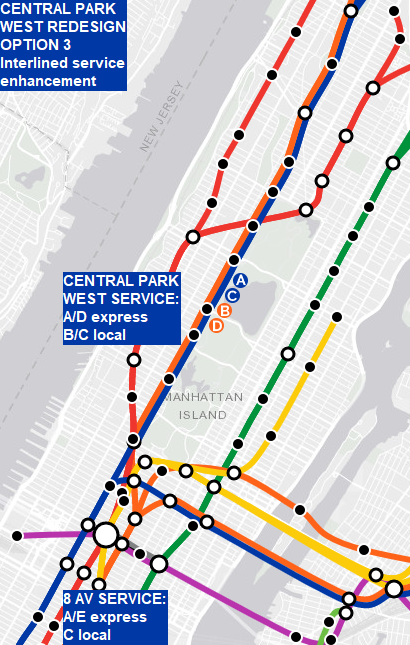
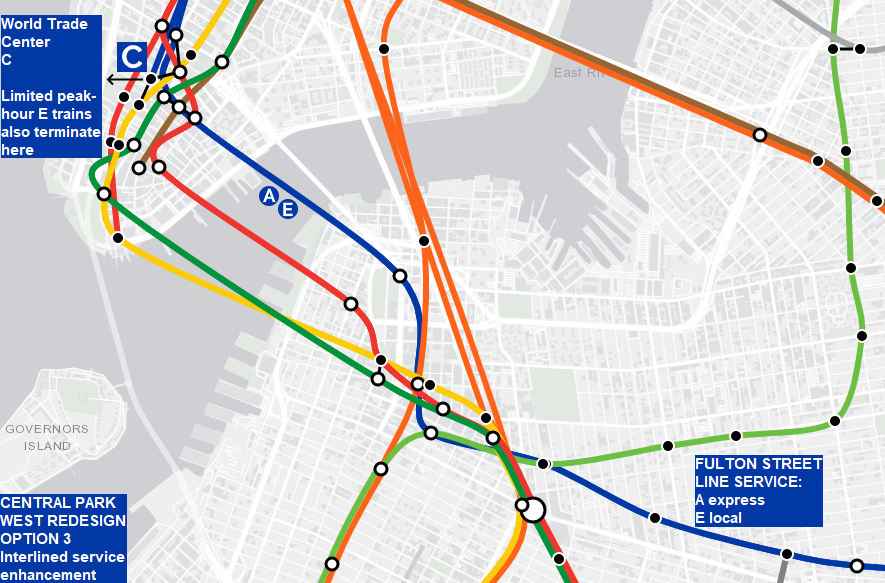
I like Option 2 better, because then the CPW local stops aren’t cut off from the 8th Ave section of the line (CPW really is the Uptown extension of the 8th Avenue Subway), as they would be in Option 1. Though I imagine that presented with this option (Option 2) there may be people who bemoan the loss of the A express (the A train as a local would no longer be “the quickest way to Harlem,” like in the song). But I’d rather have the same route(s) serving all of the CPW/8th Avenue local stops.
I would also flip the A and E Brooklyn, so the E is local and the A express. If the E is express, then it will be the longest route in the system, possibly longer than the current A service.
Hi Mike:
The pattern you suggested for the A and E in Brooklyn could also work, as it wouldn’t interfere with the CPW de-interlining. I think it’d ultimately come down to rider preference.
You think 96 st should be converted into an express stop I was thinking it would makes changing local and express service easier. I was thinking he could just have the A train run local and have the B train run express
But that has a whole bunch of problems. Grand Concourse riders would lose access to a one seat ride to local Central Park west service. And trust me with the A train current route YOU DO NOT WANT TO HAVE THE A TRAIN RUN LOCAL. Riders would be PISSED. The A train run the longest route in the entire system so a Local A train is DEFINITELY going to anger A train riders. Needless to say this deinterlocking is like decoding subway service
Here’s a minor change that would help improve A/C train service. Extended the C train to lefferts blvd. I know the A train is very busy and special but does it SERIOUSLY NEED 3 terminals at once. Just divert the A train into Far Rockaway and maybe a few rush hours trains to Rockway Park 116th st& take out Lefferts Blvd. Have the C train take over Lefferts blvd for the A train. It’s actually very annoying and frustrating to have wait at either station from Aqueduct Racetrack to Far Rockaway for one single A train, all because LIKE HALF OF THE ENTIRE A train fleet go to Lefferts. If ALL A trains went to Far Rockaway & ALL C trains went to Lefferts Blvd, I honestly think there won’t be problems for both passengers who depend service to/from Lefferts & to/from Far Rockaway. Here’s how it would benefit service but the negative impact it would have.
Pros:
1) Passengers willing to go to stations from C local stops from the Fulton St line to the Liberty Av Elevated can just stay on the C train instead of transferring to the A.
2) The A train would no longer have to split services at Rockway blvd
3) The extra A train fleet could be used to provide More frequent service to/from the Rockaways if all A trains are diverted to Far Rockaway or Rockaway Park.
4) C train riders would have a one seat ride to queens
5) reduced waiting times at both Lefferts and Rockway lines
Bonus ???. The C train finally gets fresh air?????
Cons:
1) Passengers from 104 St – Lefferts Blvd want instant EXP Service to Manhattan during the AM Rush.
2) Possible switch problems at Euclid Av if tracks were switched a lot more than often.
3) Congestion may happen, if a delay occurs via the Liberty Av Elevated.
4) Lefferts would be reduce to 8 cars hence limiting passenger service
So good plan but we need to plan carefully I propose having the 2nd ave line build with a connection to the Fulton st line have the T train take over local service and run to Euclid Avenue and move the C train to the express tracks along side the A train this would Aloud C trains to be extended to Lefferts blvd without creating YET ANOTHER interlocking issue what do you think of this plan
The C to Lefferts would realize immediate improvement for A service to the Rockaways, but would add an extra merge past Euclid. (And of course, replacing an express with a local – even if the latter’s more frequent – may be a challenge.)
Consequently, the SAS-Fulton link is a key element of NYTIP (future post), for exactly the reasons you stated. SAS via Fulton Local, all 8th Avenue service express – then one line serves Lefferts and the other serves the Rockaways. One of the Rockaway branches replaces the Rockaway Park shuttle, providing significant improvement for Rockaway Park branch riders.
Or if possible we can connect the Broadway to the Fulton st line and sent the W train to Euclid Ave and have it run local moving the C train to the express tracks. This is another way to extend the C to Euclid ave without creating a interlocking problem
I don’t see a need for a Broadway line extension via Fulton Street. SAS is clearly the better fit here IMHO.
I think swapping the b and c is a good idea. But, there would never be a moment where people would get mad and say “Why did the D become local?” then, I don’t want a situation to be where if a passenger said “Is the C running local?” and they say “No. It’s express.” and then the passenger punching the conductor during a tantrum about your plan. For example, if a man said “Is the D running express?” and the conductor said “No. According to the plan from nerdynel.me, the C is running express and the D is running local.” and the man who asked that question threw a tantrum and punched a conductor. I would not sit next to a person who punched a conductor due to the CPW service under nytip. Also, I wouldn’t punch a conductor due to the C no longer stopping at 50th street and the E running local independently.
I get the sentiment, but note that all of the NYTIP proposals wouldn’t be implemented “on a Sunday morning”, as the saying goes. Since even the de-interlining swaps constitute major changes, I imagine they’d go through a rigorous public review process after officials explain the rationale for such changes.
Even after such a review process, assuming the changes go through, you could deploy ambassadors to stations to help passengers become familiar with the new patterns, similar to what MTA did when they rolled out Select Bus Service.
I wanted to tell you that I’m enjoying this series. You are putting together some very realistic and cost effective recommendations that could greatly speed up train service.
I like that your recommendation allows that both Inwood and Concourse customers have access to both a local and an express train at most times. While that is not a pure deinterlining (some people’s plans involve sending all Concourse trains to CPW express and all Inwood trains to CPW local to avoid the merge at 145th), it is far more palatable to most of the effected people. And, most importantly, it avoids the merging at 59th which is a far busier point.
Hi mrsman:
Thank you for your comments and commendations! I’m glad you’re enjoying this series!
Indeed, while my plan is not a complete de-interlining, it is the option likely to encounter the least resistance and minimize inconvenience.
You hit on a key goal of NYTIP – maximizing efficiency at minimal cost (I’m aware “minimal” may be relative, given NY’s outrageous costs). NY desperately needs cost reform!